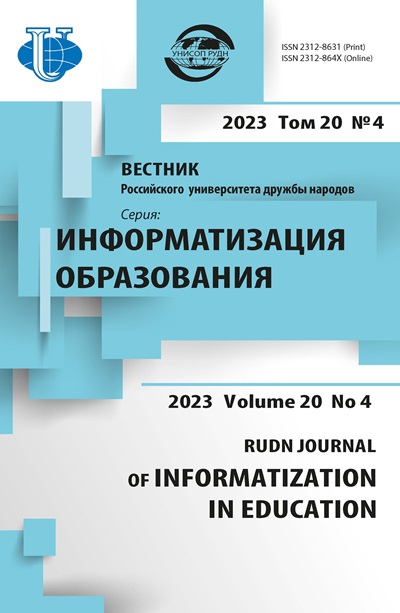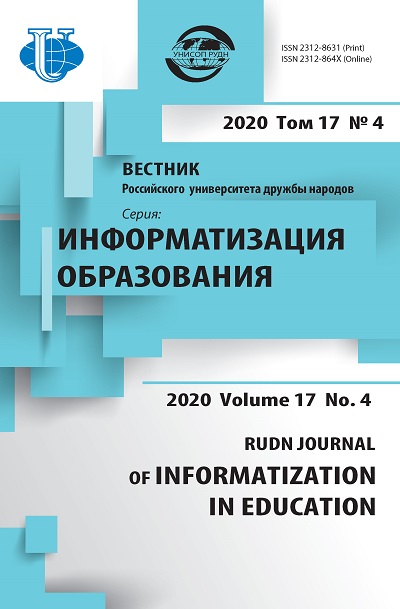Opportunities to use interactive tasks in chemistry within the Middle Years Programme (basic school) of the International Baccalaureate
- Authors: Tomin V.I.1
-
Affiliations:
- School No. 1517 in Moscow
- Issue: Vol 17, No 4 (2020)
- Pages: 337-348
- Section: EDUCATIONAL ELECTRONIC PUBLICATIONS AND RESOURCES
- URL: https://journals.rudn.ru/informatization-education/article/view/25392
- DOI: https://doi.org/10.22363/2312-8631-2020-17-4-337-348
Cite item
Full Text
Abstract
Problem and purpose. Information and communication technologies (ICT) are considered one of the most progressive and effective means of increasing interest in learning, as well as developing students in modern teaching methods. In Russia, the use of ICT and the development of its theoretical aspects in teaching chemistry under the Middle Years Programme (MYP, basic school) of the International Baccalaureate is at an embryonic level and, therefore, is a modern and very urgent problem of the education system within the framework of the International Baccalaureate. New methods and means based on the use of ICT in the educational process contribute to the growing interest in the study of chemistry. Increasing the level of independence in educational activities within the framework of working with ICT contributes to the formation of a competent, developed personality, teaches children to make adequate decisions, and motivates to improve self-preparation for lessons. Thanks to the continuous movement of modern education towards change and progress, there are more and more new developments and teaching aids that can be used in teaching chemistry. All this contributes to the creation and maintenance of a stable interest in educational processes, both in the independent search and solution of problems, and at school in the classroom. Often, the generally accepted approaches to the study of the topic of valence, existing today, do not give the desired and desired results. And the insufficient assimilation of this topic by students leads to a deterioration in academic performance in the further paragraphs of the chemistry course of the basic school curriculum. In the MYP (basic school), the study of the topic “Valence” is replaced by an explanation of the concepts of electronegativity and oxidation state, which leads to the loss of one of the fundamental concepts in chemistry. That fact defines the problem of the article. The purpose of the article is to describe approaches to increasing the interest and attention of students in the context of the use of innovative interactive technologies. Methodology. The methodological basis was the scientific and methodological works of A.K. Akhlebinin, N.P. Bezrukova, G. Vern, L.S. Vygotsky, P.Ya. Galperin, S.A. Gerus, A.A. Zhurin, V.V. Zagorsky, L. S. Zaznobina, O.S. Zaitsev, M.V. Zueva, R.G. Ivanova, N.E. Kuznetsova, G.Ya. Lastushkina, T.S. Nazarova, E.I. Mashbitsa, E.S. Polat, L.F. Pleukhova, I.V. Robert, T.A. Sergeeva, N.F. Talyzina, S.G. Chaikova, G.M. Chernobelskaya, L.L. Chunikhina, M. Shanon. Results. The expediency of using interactive tasks in chemistry (on the example of the topic “Valence”) in teaching schoolchildren under the MYP has been substantiated by increasing the general level of academic performance on this topic, as well as interest in chemistry lessons. Approaches to the selection of content (on the example of the topic “Valence”) for the creation of interactive tasks, including scientific, systematic, age-appropriate, are determined. A system of interactive tasks for studying the topic “Valence” under the MYP was developed and tested, which contains teaching materials for preparing students on the specified topic, including the theoretical part and analysis of examples. Conclusion. The results allowed to conclude that the creation and use of a specially prepared system of interactive tasks in chemistry (using the example of the “Valence” topic) for the MYP leads to a significant simplification of the study of this topic and an increase in the level of intrinsic motivation to study chemistry.
About the authors
Vladimir I. Tomin
School No. 1517 in Moscow
Author for correspondence.
Email: tominvi@gym1517.ru
chemistry teacher
11 Zhivopisnaya St, bldg 1, Moscow, 123103, Russian FederationReferences
- Ahlebinin AK. Sistema mnogofunkcional'nyh interaktivnyh obuchayushchih zadanij s mul'timedia komponentami dlya elektronnogo uchebnika himii [System of multifunctional interactive training tasks with multimedia components for an electronic chemistry textbook]. Sbornik nauchnyh rabot laureatov oblastnyh premij i stipendij [Collection of scientific papers of winners of regional prizes and scholarships]. 2006;2:107–115.
- Ahlebinin AK. Nekotorye problemy ispol'zovaniya elektronnyh izdanij uchitelyami himii [Some problems of using electronic publications by chemistry teachers]. Informacionnye tekhnologii v obrazovanii [Information technologies in education]: proceedings of the XVI International conference-exhibition. 2006;3:13–14.
- Zaznobina LS, Nazarova TS, Morozova TN, Shapovalenko CB. Bank vizual'noj informacii kak nauchnaya tekhniko-pedagogicheskaya zadacha [Bank of visual information as a scientific technical and pedagogical task]. Informatika i obrazovanie [Informatics and education]. 1996;(4):1–4.
- Gabrielyan OS. Obshchaya himiya v testah, zadachah, uprazhneniyah: 11 klass [General chemistry in tests, tasks, exercises: grade 11]. Moscow: Drofa Publ.; 2003.
- Grabeckij AA, Zaznobina LC, Nazarova TS. Ispol'zovanie sredstv obucheniya na urokah himii [Use of teaching tools in chemistry lessons]. Moscow: Prosveshchenie Publ.; 1988.
- Zagorskij VV. Internet-resursy dlya uchitelya [Internet resources for teachers]. Himiya v shkole [Chemistry at school]. 2003;(9):2–7.
- Pak MS. Algoritmy v obuchenii himii [Algorithms in teaching chemistry]. Moscow: Prosveshchenie Publ.; 1993.
- Chernobelskaya GM. Osnovy metodiki obucheniya himii [Fundamentals of chemistry teaching methods]. Moscow: Prosveshchenie Publ.; 1987.
- Grigorev SG, Grinshkun VV. Informatizaciya obrazovaniya: fundamental'nye osnovy [Informatization of education: the fundamental bases]. Moscow: MGPU Publ.; 2005.
- Zaslavskaya O. Yu. Informatizaciya obrazovaniya: novoe ponimanie mesta i roli uchitelya v uchebnom processe [Informatization of education: a new understanding of the place and role of teachers in the educational process]. Vestnik Moskovskogo gorodskogo pedagogicheskogo universiteta. Seriya: Informatika i informatizacija obrazovanija [Bulletin of the Moscow City Pedagogical University. Series: Informatics and Informatization of Education]. 2007. No 9. Pp. 81 – 82.
- Zaslavskaya OYu. Transformaciya obrazovaniya v usloviyah razvitiya cifrovyh tekhnologij [Transformation of education in the conditions of development of digital technologies]. Gorizonty i riski razvitiya obrazovaniya v usloviyah sistemnyh izmenenij i cifrovizacii [Horizons and risks of development of education in the conditions of system changes and digitalization]: collection of scientific papers of the XII International scientific and practical conference. Moscow: Mezhdunarodnaya akademiya nauk pedagogicheskogo obrazovaniya; 2020. p. 70–74.
- Zaslavskaya OYu. Vozmozhnosti setevyh obrazovatel'nyh resursov dlya podgotovki kriterial'no-orientirovannyh zadanij [Opportunities of network educational resources for preparation of criteria-oriented tasks]. Vestnik Moskovskogo gorodskogo pedagogicheskogo universiteta. Seriya: Informatika i informatizacija obrazovanija [Bulletin of the Moscow City Pedagogical University. Series: Informatics and Informatization of Education]. 2016;4(38):37–43.
- Nazarova TS, Tihomirova KM, Kudina IYu, Kozhevnikov DN, et al. Instrumental'naya didaktika: perspektivnye sredstva, sredy, tekhnologii obucheniya [Instrumental didactics: promising tools, environments, learning technologies]. Moscow, Saint Petersburg; 2012.
- Robert IV. Sovremennye informacionnye tekhnologii v obrazovanii: didakticheskie problemy, perspektivy ispol'zovaniya [Modern information technologies in education: didactic problems, prospects for use]. Moscow: Shkola-Press; 1994.
- Ahlebinin AK, Lazykina LG, Lihachev VN, Nifantev EE. Demonstracionnyj eksperiment po himii na mul'timedijnom komp'yutere [Demonstration experiment in chemistry on a multimedia computer]. Himiya v shkole [Chemistry at school]. 1999;(5):56–60.
















